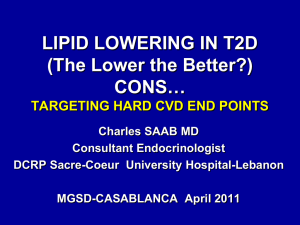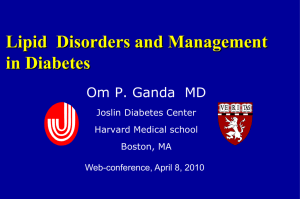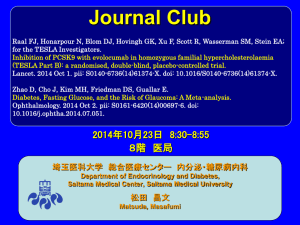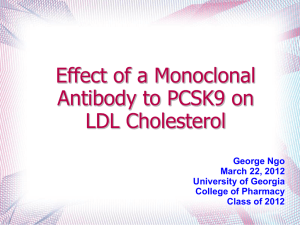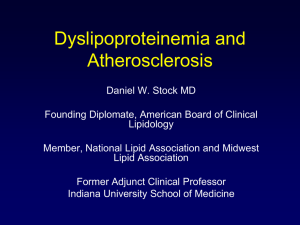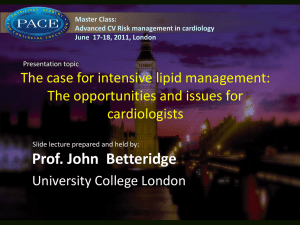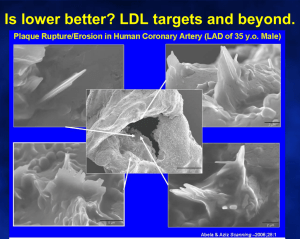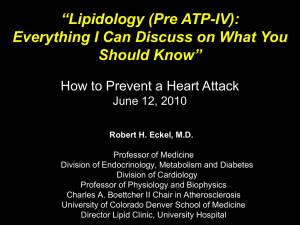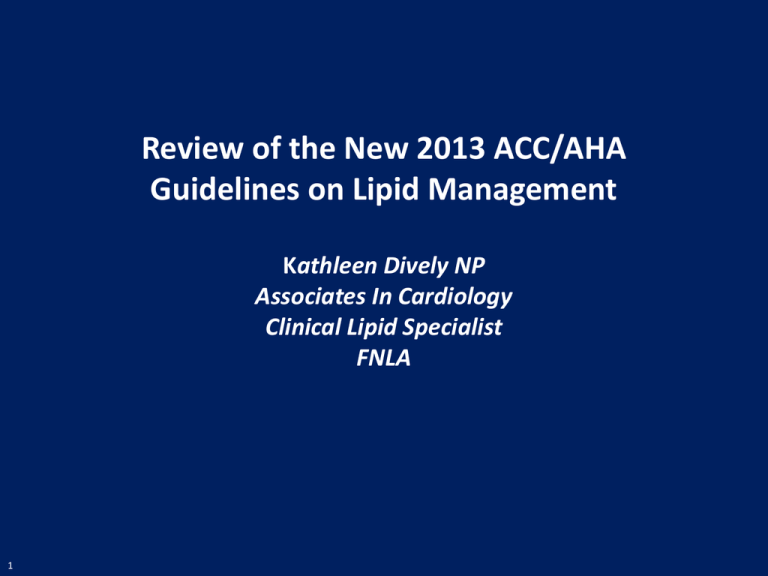
Review of the New 2013 ACC/AHA
Guidelines on Lipid Management
Kathleen Dively NP
Associates In Cardiology
Clinical Lipid Specialist
FNLA
1
Objectives
1. Discuss and review major changes including the lack of
target LDL
2. Discuss the role of niacin and ezetimibe
3. Dicuss the role of biomarker ie ApoB, CIMT
4. Discuss the use of combination therapy
5. Discuss the use of high dose statin therapy
6. Discuss the management of residual risk
-
2
Previous Guidelines
– The first priority of treatment is to treat LDL-C
to goal (unless TG is >500)
Non-HDL-C
should be a secondary
treatment target, if LDL-C at goal but TG is
≥200 mg/dL
Always
screen for residual risk , Look at
more than the LDL-C
3
Establish Goals of Therapy based on risk factors & Lab evaluation
Multivariable
Risk Assessment
High Risk
LDL Management
Lifestyle/statin/other
If above goal
CHD/CHD Risk Equiv.
(>20% 10-year risk)
Treatment
Assessment & Goal
LDL-C < 100
(LDL-P < 1000)*
Intermediate
Risk
Treatment
Assessment & Goal
LDL-C < 130
(LDL-P < 1300)*
LDL-C < 160
(LDL-P < 1600)*
2+ Risk Factors
(10-20% 10-year risk)
Low Risk
0-1 Risk Factors
(0-10% 10 year risk)
Treatment
Assessment & Goal
*Based on population
equivalent cut points
1. Contois JH et al. Clin Chem. 2009;55:407-419
2. Cromwell WC. In: Clinical Challenges in Lipid Disorders.Toth PP, Sica DA, editors. Oxford: Clinical Publishing; 2008.p. 249-59.
3. Cromwell WC, Barringer TA. Curr Cardiol Reports 2009;11(6):468-475
4
ACC/AHA Guideline on the
Assessment of Cardiovascular Risk
The last NCEP-ATPIII report was delivered in 2001 with
an update in 2004. There has been no concensus
reached with ATP IV so the 16 member group
reconvened under the auspices of the ACC/AHA and
were limited to review only level one research.
In response to the 2011 report of the Institute of
Medicine on the development of trustworthy clinical
guidelines (1), the NHLBI Advisory Council (NHLBAC)
recommended that the NHLBI focus specifically on
reviewing the highest quality evidence
Stone NJ et al. Task Force on Practice Guidelines. Circulation or JACC: on line 2013
Level I Evidence
[ This definition,: Evidence obtained
from at least one properly designed
randomized controlled trial. and
therefore considered ( LIKELY reliable )
1.
ACC/AHA Guideline on the Treatment of
Blood Cholesterol to Reduce Atherosclerotic
Cardiovascular Disease in Adults
There is no evidence to support continued
use of specific LDL-C and/or non–highdensity lipoprotein cholesterol (non–HDL-C)
treatment targets
Stone NJ et al. Task Force on Practice Guidelines. Circulation or JACC: on line 2013
ACC/AHA Guideline on the Treatment of
Blood Cholesterol to Reduce Atherosclerotic
Cardiovascular Disease in Adults
The following are no longer considered appropriate
strategies: treat to target, lower is best. The new GL
recommends: treat to level of ASCVD risk, based upon
estimated 10-year or lifetime risk of ASCVD. The
guidelines provided no recommendations for initiating
or discontinuing statins in NYHA class II-IV ischemic
systolic heart failure patients or those on maintenance
hemodialysis.
Stone NJ et al. Task Force on Practice Guidelines. Circulation or JACC: on line 2013
ACC/AHA Guidelines for 4 Classes of Statin
Eligible Patients
Individuals with LDL> 190 mg/dl
Age 40-75 with LDL 70-189mg/dl without ASCVD
assess 10 year risk, treat if > 7.5%
Age 40-75 with Diabetes and no ASCVD with LDL-C
between 70-189mg/dl
Individuals with clinical ASCVD
No recommendations for CHF or hemodialysis
patients.
Stone NJ et al. Task Force on Practice Guidelines. Circulation or JACC: on line 2013
Statin Eligible
• Estimated that 44% of men
• 22% of women
• Under the old guidelines about 15% are eligible
ACC/AHA Guideline on the
Assessment of Cardiovascular Risk
►
The contribution to risk assessment for a first ASCVD
event using ApoB, CKD, albuminuria, or
cardiorespiratory fitness is uncertain at present
►
CIMT is not recommended for routine measurement in
clinical practice for risk assessment for a first ASCVD
event
Stone NJ et al. Task Force on Practice Guidelines. Circulation or JACC: on line 2013
ACC/AHA Guideline on the
Assessment of Cardiovascular Risk
►
The use of ezetimibe is no longer recommended as a
valid treatment for lipid management.
►
The use of niacin was not addressed
►
The use of fibrates and omega 3s were not addressed
►
The use of combination therapy was not addressed due
to lack of clinical evidence.
Stone NJ et al. Task Force on Practice Guidelines. Circulation or JACC: on line 2013
ACC/AHA Guideline on the
Assessment of Cardiovascular Risk
High-intensity statin therapy is defined as a
daily dose that lowers LDL-C by ≥50% and moderateintensity by 30% to <50%. All patients with ASCVD,
should receive high-intensity statin therapy; or if not
a candidate for high-intensity, should receive
moderate-intensity statin therapy.
Stone NJ et al. Task Force on Practice Guidelines. Circulation or JACC: on line 2013
ACC/AHA Guideline on the
Assessment of Cardiovascular Risk
LDL-C ≥190 mg/dl : Should receive high-intensity or
moderate-intensity statin therapy.
Statin Intolerant: Other cholesterol-lowering agents can be
considered to further lower LDL-C.
Diabetics with a 10-year ASCVD ≥7.5%: Should receive highintensity statins and <7.5% moderate-intensity statin therapy.
Persons 40-75 years with a ≥7.5% 10-year ASCVD risk:
should receive moderate- to high-intensity statin therapy.
Stone NJ et al. Task Force on Practice Guidelines. Circulation or JACC: on line 2013
ACC/AHA Guideline on the
Assessment of Cardiovascular Risk
To the patients not in the 4 statin groups
Individuals whose 10-year risk is <7.5%
Family history of premature ASCVD,
LDL-C >160 mg/dl,
HS-crp ≥2 mg/dl,
Coronary calcium score ≥300 Agatston units
ankle-brachial index <0.9
Elevated lifetime risk of ASCVD may be used to
enhance the treatment decision making.
Stone NJ et al. Task Force on Practice Guidelines. Circulation or JACC: on line 2013
ACC/AHA Guideline on the
Assessment of Cardiovascular Risk
Lifestyle modification (i.e., adhering to a heart
healthy diet, regular exercise habits, avoidance
of tobacco products, and maintenance of a
healthy weight) remains a critical component of
health promotion and ASCVD risk reduction,
both prior to and in concert with the use of
cholesterol-lowering drug therapies.
Stone NJ et al. Task Force on Practice Guidelines. Circulation or JACC: on line 2013
Basically all targets have been
removed
Risk stratification remains, but is much
more lenient
Risk stratification, Statin eligible
patients
10
year risk >7.5%
(was > 20%)
Risk Factors, optimal levels
Total
Cholesterol
HDL
Systolic
b/p
170mg/dl
50mg/dl
110mmhg
Desk-top ACC Risk Calculator
10
year risk ages
Life-time risk ages
40-79yr
20-59yr
Pt age 55, non-smoker, TC 213, HDL50, systolic
b/p 120 ( untreated), non-diabetic
White women
2.1%
African American women
3.0%
White man
5.3%
African American Man
6.1%
Risk Assessment Calculator/No targets of therapy
Enter patient values
in this column
Risk Factor
Sex
Age
Units
Value
Acceptable range of values
M (for males) or F (for females)
f
M or F
Optimal values
years
59
20-79
AA (for African Americans) or WH (for whites or others)
wh
AA or WH
Total Cholesterol
mg/dL
229
130-320
HDL-Cholesterol
mg/dL
86
20-100
50
mm Hg
130
90-200
110
Treatment for High Blood Pressure
Y (for yes) or N (for no)
n
Y or N
N
Diabetes
Y (for yes) or N (for no)
n
Y or N
N
Smoker
Y (for yes) or N (for no)
n
Y or N
N
Race
Systolic Blood Pressure
170
10-Year and Lifetime ASCVD Risks
45.0
Your 10-Year ASCVD Risk (%)
2.5
40.0
35.0
Your Lifetime ASCVD Risk* (%)
2.1
39.0
30.0
Predicted Risk (%)
10-Year ASCVD Risk (%) for Someone Your Age with
Optimal Risk Factor Levels (shown above in column E)
25.0
20.0
15.0
10.0
Lifetime ASCVD Risk (%) for Someone at Age 50 with
Optimal Risk Factor Levels (shown above in column E)
8.0
5.0
0.0
Your 10-Year ASCVD
Risk (%)
*This is the lifetime ASCVD risk for an individual
at age 50 years with your risk factor levels. In rare
cases, 10-year risks may exceed lifetime risks
given that the estimates come from different
approaches. While 10-year risk estimates are
derived from methods and data using continuous
variables, the reported estimate of lifetime risk is
based on assigning each person into one of 5
21
10-Year ASCVD Risk
(%) for So meon e
Your Age with
Optimal Risk Factor
Levels (sh own ab ove
in colu mn E)
Your Lifetime ASCVD Lifetime ASCVD Ris
Risk* (%)
(%) for So meon e a
Age 50 with Optima
Risk Facto r Levels
(sh own ab ove in
column E)
46 year old white male ,
Family history of HD .
TC 164
LDL79
TRI 247
HDL41
FBS 75
His 10 year risk with the new
calculator was 2%.
Asymptomatic, Abnormal
stress referred for LHC.
90% proximal LAD
Pt was on lipitor and niaspan.
Abnormal phytosterol levels.
Changed to crestor.
LVH by echo. b/p med changed
LDLp 1245 (LDLc 75)
►
Given the strong evidence that statins reduce risk across the range
of LDL levels, the best preventive strategy may be to use the
patient’s global cardiovascular risk to determine treatment.
►
The absolute benefit of statins is greatest for those at higher risk—
and those at highest risk would tend to benefit most from higher
dose or higher potency statins.
►
The benefit diminishes with decreasing risk. A recent analysis of
statins for primary prevention showed that a strategy using statins
based on patient risk rather than LDL levels can prevent more
cardiovascular events while treating fewer people with high dose
statins.
BMJ 2010;341:332-333
“Clear, compelling evidence supports near-universal
empirical statin therapy in patients at high cardiovascular
risk (regardless of their natural LDL cholesterol values),
but current clinical evidence does not demonstrate that
titrating lipid therapy to achieve proposed low LDL
cholesterol levels is beneficial or safe.”
Ann Intern Med. 2006;145:520-530
Evidenced Based Medicine
►
We conclude that there is clear and compelling evidence
that most patients at high risk for cardiovascular disease
should be taking at least a moderate dose of a statin if
tolerated, even if their natural LDL cholesterol level is low
►
We could find no published high-quality clinical evidence
supporting titration of lipid therapy based on proposed LDL
cholesterol targets
►
We strongly suggest that those with access to these data
conduct further analyses to provide more valid evidence on
this important clinical and scientific question
Hayward RA et al. Ann Intern Med. 2006;145:520-530
► The
trials of cholesterol lowering treatments tested the
effect of fixed doses of drugs, not a strategy of
progressively intensifying lipid therapy without regard to
strategy to reach specific target ranges
Save a ton of money – No follow up lab tests!
No follow up phone calls!
BMJ 2010;341:332-333
The first outcome trial
ever done using a statin
►
4444 patients with angina pectoris or previous myocardial infarction
and serum cholesterol 212 – 308 mg/dL on a lipid-lowering diet were
randomized to double-blind treatment with simvastatin or placebo
►
Dosage was adjusted, if necessary, at the 12-week and 6-month visits,
on the basis of serum total cholesterol at 6 and 18 weeks. The goal of
treatment was to reduce serum total cholesterol to 3.0-5.2 mmol/L
(115-200 mg/dL)
►
Patients in the simvastatin group whose serum cholesterol was out of
range had their dose increased to 40 mg daily, as two 20 mg tablets,
or reduced to one 10 mg tablet
Pedersen TR. Lancet 1994;344:1383-1389
The Politics of Evidence-Based Medicine
Evidence-based medicine has enabled payers,
purchasers, and governmental authorities to use
their financial clout to alter the practice of
medicine.
Traditionally doctors defined the standard of
care. Now, armed with more and better
information about medical practices, payers and
purchasers can deny payment for medical
services that they deem medically unnecessary
or ineffective.
In so doing, they redefine standards for
appropriate medical practice.
By Marc A. Rodwin, Indiana University Journal of Health
Politics, Policy and Law, Vol. 26, No. 2, April 2001
http://www.ahrq.gov/clinic/jhppl/rodwin.htm
Unmet Need: Persistent Incidence of CHD
Framingham Heart Study 26 year f/u, Indicates that
Measuring Cholesterol Does Not Tell Us Enough
• 80% of subjects with
cardiac events had
lipid levels similar to
subjects that were
event free
• 35% of CHD occurs
in people with
TC<200
20/100
40/100
90/100
Should we consider a failure in detection of risk by
“standard methods” an appropriate reason to increase
the number of statin eligible patients and forfeit our
present guidelines?
32
New ACC/AHA Guidelines
• Lipids, there is no longer any support for treating
to specific targets
• Obesity, There is no ideal diet for weight loss
• Risk Assessment, New calculator for 10 year risk
assessment ages 40-75. Ages 20-59 life-time
calculator.
(my.americanheart.org/cvriskcalculator)
• Lifestyle, restriction of fat and sodium
Steps 2 & 3: Establish Goals of Therapy & Lab evaluation
Multivariable
Risk Assessment
High Risk
LDL Management
Lifestyle/statin/other
If above goal
CHD/CHD Risk Equiv.
(>20% 10-year risk)
Treatment
Assessment & Goal
LDL-C < 100
(LDL-P < 1000)*
Intermediate
Risk
Treatment
Assessment & Goal
LDL-C < 130
(LDL-P < 1300)*
LDL-C < 160
(LDL-P < 1600)*
2+ Risk Factors
(10-20% 10-year risk)
Low Risk
0-1 Risk Factors
(0-10% 10 year risk)
Treatment
Assessment & Goal
*Based on population
equivalent cut points
1. Contois JH et al. Clin Chem. 2009;55:407-419
2. Cromwell WC. In: Clinical Challenges in Lipid Disorders.Toth PP, Sica DA, editors. Oxford: Clinical Publishing; 2008.p. 249-59.
3. Cromwell WC, Barringer TA. Curr Cardiol Reports 2009;11(6):468-475
34
Potential problems
• NO TARGETS OF THERAPY
difficult for patient motivation ,
promotes apathy on the part of the provider
• NO ROUTINE LABS
difficult for motivation, risk
• HIGH DOSE STATIN
side effects
• HIGH RISK POPULATIONS
ischemic CHF, CKD
• COMBINATION TX
excluded
• WIDE SPREAD USE OF STATINS increased costs
• ETHNIC SPECIFIC ALGORITHMS not addressed
•
• INCREASED PAYOR DENIALS considered guidelines for us (not
mandates) but do we really have a choice when payors deny
35
Ezetimibe (Zetia)
• Bowel absorption inhibitor
• Works at the brush border of the small intestine.
36
Cholesterol torsHo
LDL
apoB100
Liver
Duodenum
VLDL
apoB100
X
Ezetimibe
Jejunum
Ileum
CM Remnant
apoB48
37
CM
apoB48
Colon
Niacin effectiveness in reducing events.
•
•
•
•
38
Fats trial ( Familial hypercholesterolemia )
Hats trial (HDL atherosclerosis tx )
AFREGS (airforce regression)
Aim High ( no residual risk)
78 %
61 %
53 %
0
RESIDUAL RISK IS NOT
ADDRESSED
RESIDUAL RISK IS NOT
ADDRESSED
Evidence of Residual CVD Risk
• 136,905 hospitalizations for
(non-CHF) CAD and lipids w/in
24 hrs of admit (at 541
hospitals)
• Over 50% of patients with
LDL-C <100 mg/dL and 17.6%
with LDL-C <70 mg/dL
• For patients without h/o CAD,
72.1% with LDL-C <130 mg/dL
and 41.5% with LDL-C <100
mg/dL
Sachdeva A, et al. Am Heart J 2009; 157:111-7.e2.
From AHA’s Get with The Guidelines (GWTG) CAD Program and database; 2000-2006.
40
Residual Cardiovascular Risk
in Major Statin Trials
Patients Experiencing
Major Coronary Events, %
100
75%
80
75%
73%
69%
62%
62%
60
40
20
0
4S
LIPID
CARE
HPS
WOS
AFCAPS /
TexCAPS
N
4444
9014
4159
20 536
6595
6605
LDL
-35%
-25%
-28%
-29%
-26%
-25%
Secondary
41
High Risk
Primary
Adapted from Libby PJ, et al. J Am Coll Cardiol, 2005:46:1225-1228.
Should we consider a failure in detection of risk by
“standard methods” an appropriate reason to increase
the number of statin eligible patients and forfeit our
present guidelines?
42
NO!
43
Groups that have come out with position statements
in support of lipoprotein testing
American Diabetes Association / American College of Cardiology Foundation
Consensus Statement [3]
American Association for Clinical Chemistry Lipoproteins & Vascular Diseases
Working Group Recommendations [1]
American Association of Clinical Endocrinologists Guidelines for Management of
Dyslipidemia [4]
National Lipid Association Expert Recommendations [5]
Canadian Cardiovascular Society Guidelines [6]
ESC/EAS Guidelines for the Management of Dyslipidemia [7]
1] Contois JH Clin Chem 2009;55:407-419
2] Otvos et al. J Clin Lipidol 2011;5:105-113
3] Brunzell JD et al. j Am Coll Cardiol
2008;51:1512-1524
4] Jellinger PS et al. Endocr Pract 2012;18(suppl 1), 1-78 European Society of Cardiology and European Athrosclerosis society
44
What’s the difference between
Lipoproteins and Cholesterol ?
=
Lipoprotein
=
Cholesterol
Question #1: What causes traffic jams to
occur on a highway ?
=
Number of
cars not the
number of
passengers
“LDL” should not imply LDL-Cholesterol
Apo B
POLAR
SURFACE COAT
Phospholipid
Free cholesterol
The LDL Particle
NONPOLAR
LIPID CORE
Cholesterol Ester
Triglyceride
LDL-Cholesterol = the weight of
the constituent cholesterol
within the particle
48
Cholesterol
Molecules
Apoprotein B-100
Apoprotein B-100
Triglyceride
Molecules
LDL A Particle
49
Cholesterol
Molecules
Triglyceride
Molecules
LDL B Particle
LDL-C can vary with particle size
At the same LDL cholesterol, more small LDL vs. large LDL particles present
Up to 70%
More Particles
100 mg/dL
100 mg/dL
Large LDL
Small LDL
Cholesterol
Balance
Otvos JD et al. Am J Cardiol 2002;90(suppl):22i-29i
Cromwell WC et al. J Clin Lipidology. 2007;1(6):583-592.
50
LDL particle number (LDL-P), as opposed to size,
is a key driver of atherogenic plaque formation
Endothelial Cell
Arterial Wall
LDL Particle
Endothelial Gap
A gradient driven process,
LDL particles invade the arterial
wall and set in motion the
cascade of events that leads to
atherosclerosis1,2
After adjustment for LDL-P
concentration, particle subclass
and size do not impact
outcomes 3
51
1. Fredrickson et al. NEJM 1967; 276: 148
2. Brunzell, et al. Diabetes Care. 2008;4:811-822
3. Ip et al . Ann Intern Med. 2009;150:474-484
Lipoprotein Particles
Density (g/ml)
0.95
IDL
1.006
LDL
1.06
LDL
Cholesterol
HDL
Triglycerides
(mainly)
HDL
Cholesterol
1.20
5
52
52
Chylomicron
Remnants
1.02
1.10
Chylomicrons
VLDL
10
20
40
60
Diameter (nm)
80
1000
Why Alternate Measures of LDL
Quantity are Not Equivalent
Concordance:
• LDL-C and LDL-P “agree” (i.e., are equally high or low)
• Either LDL measure is an equally good guide to LDL
treatment decision-making.
Discordance:
• LDL-C and LDL-P “disagree” (i.e., the values differ, either in
their relationship to the normal range or to each other)
• Which LDL measure should guide clinical decision-making?
53
CHD Event Associations of LDL-P versus LDL-C
Framingham Offspring Study
Cromwell WC et al. J Clin Lipidology 2007;1(6):583-592.
54
Friedwald Equation (is used to calculate
the bad cholesterol, LDL)
• LDL Cholesterol=Total chol-(HDL)-(TG/5)
• It assumes all the TG is carried on VLDL
• And the TG/CHOL ratio of VLDL is constant at
5:1
• NOT TRUE when TG>200, DM or metabolic
syndrome exist with ^ Chilomycrons, get falsely
low HDL and LDL.
55
Metabolic Syndrome
• Triglycerides > 150mg/dl
• FBG > 100 ( or DM)
• Waist circumference > 35 inches in a women or 40
inches in a man
• HTN (>130/85 mmHg) or taking B/p medication
• HDL-C <40mg/dl males or <50mg/dl females
• NCEP Definition of Metabolic Syndrome 2001 Guidelines
56
56
How NMR Lipoprotein Analysis works
57
NMR Lipoprotein Analysis
Lipoprotein subclasses of different size broadcast lipid NMR signals that
are naturally distinguishable. The measured amplitudes of these signals
provide subclass quantification.
Jeyarajah EJ et al. Clin Lab Med 2006;26:47-70
58
NMR Measures LDL Particle Number,
Not LDL Cholesterol
Measured
LDL-C
90 mg/dL
LDL particles
900 nmol/L
59
Measured
LDL-C
90 mg/dL
LDL NMR
Signals
LDL particles
1600 nmol/L
Principles for determining appropriate LDL testing
guided by landmark publication
• Value of the new reference test is best examined in cases of
disagreement (discordance) between the new and standard tests.
• Clinical consequences of disagreements between new and standard
test requires a fair “umpire” test.
• Fair umpire tests include clinical events or disease progression.
Glasziou P et al. Ann Intern Med 2008;149:816-22.
60
Multiple Outcome Studies Demonstrate
Difference Between LDL-P and LDL-C
61
Relationship of LDL Particle Number
with CHD Outcomes
62
Framingham Offspring Study
• Long-running NIH/NHLBI observational study of residents of
Framingham, MA to determine risk factors for future
cardiovascular disease (CVD)
• Blood samples obtained in 1988-91 (exam 4)
– Lipids measured by traditional chemical methods
– Lipoprotein particles measured by NMR spectroscopy
• Correlated with CVD occurrence during a 15-year follow up
– 3,066 subjects
– 431 CVD events (MI, stroke, CHD death, angina, congestive heart
failure)
• Discordance defined as either above or below the median
for LDL-C and LDL-P
Cromwell WC et al. J Clin Lipidology 2007;1(6):583-592.
63
CHD Event Associations of LDL-P versus LDL-C
Framingham Offspring Study
Cromwell WC et al. J Clin Lipidology 2007;1(6):583-592.
64
Multi-Ethnic Study of Atherosclerosis (MESA)
• Large NHLBI observational study of the pathogenesis and
progression of subclinical atherosclerosis.
• N= 6,814 asymptomatic men and women free of
cardiovascular disease at entry
• 38% White
• 28% African-American
• 22% Hispanic
• 12% Asian
• 319 CVD events (MI, CHD death, angina, stroke, stroke
death, or other atherosclerotic or CVD death) occurred
during 5.5-yr follow-up (n=5598).
Otvos et al. J Clin Lipidol 2011;5:105-13
65
MESA: Study Design
• Baseline assessments:
• LDL particle number (LDL-P) measured by NMR spectroscopy
• Calculated LDL cholesterol (LDL-C)
• Carotid intima-media thickness (IMT)
• Associations of LDL-C and LDL-P with CVD events (prospective) and
carotid IMT (cross-sectional) were determined
• Overall population
• Concordant subgroup
• Discordant subgroup
• Discordance defined as LDL-C and LDL-P levels differing by 12
percentile units, to give equal-sized concordant and discordant
subgroups.
Otvos et al. J Clin Lipidol 2011;5:105-13
66
MESA: Conclusions
• The cholesterol content of LDL particles varies greatly,
causing LDL-C in many individuals to over-represent or
under-represent LDL particle concentrations.
•
LDL-C and LDL-P were both significantly associated with
incident CVD overall.
•
For individuals with concordant levels of LDL-C and LDL-P,
both measures of LDL quantity were (as expected) equally
predictive of risk.
•
For individuals with discordant levels, only LDL-P was
significantly associated with incident CVD.
• Carotid IMT also tracked with LDL-P rather than LDL-C when
these measures were discordant.
Otvos et al. J Clin Lipidol 2011;5:105-13
67
VA-HIT Background
Purpose:
Randomized, double-blind trial to determine if increasing low HDL-C will
decrease CHD events
Subjects:
2531 men with CHD, low HDL-C (31.5 mg/dL), and low LDL-C (111 mg/dL)
Therapy:
Gemfibrozil (1.2 g/d) vs. placebo
Otvos, et al. Circulation 2006;113:1556-63
68
VA-HIT: Principal Results
Gemfibrozil treatment resulted in a
22% decrease in nonfatal MI + CHD death
31% decrease in stroke
No increase in adverse events
Otvos, et al. Circulation 2006;113:1556-63
69
VA Hit Trial
• Demonstrated that gemfibrozil reduced 5-yr rate of new CHD
events.
• No effect on LDL-C, HDL-C only raised 6%, tri lowered 31%
• Increased LDL size and decreased LDL particles number (LDL-P)
• The decrease in particle number was predictive for CHD future
events.
70
VA-HIT: Alternative Measures of LDL and HDL
As Predictors of CHD Events
HDL
1.5
1.3
Odds Ratio per 1-SD Decrement
Odds Ratio per 1-SD Increment
LDL
1.2
1.1
1
LDL-C
Non-HDL-C
ApoB
LDL-P*
1.4
1.3
1.2
1.1
1
HDL-C
Adjusted for treatment, age, hypertension, smoking, BMI, and diabetes
*p<0.001
Otvos, et al. Circulation 2006;113:1556-63
71
ApoA-1
HDL-P*
Consensus and Recommendations
72
2008 ADA/ACC Consensus Statement on Lipoprotein
Management in Patients with Cardiometabolic Risk
1. “… the cholesterol content of LDL particles varies from person to person
and is influenced by metabolic abnormalities such as insulin resistance
and hyperglycemia.”
2. “Hence, measurement of LDL cholesterol may not accurately reflect the
true burden of atherogenic LDL particles, especially in those with the
typical lipoprotein abnormalities of cardio-metabolic risk.”
3. “Measurements of apoB or LDL particle number by NMR may more
closely quantitative the atherogenic lipoprotein load. Some studies
suggest that both are better indices of CVD risk than LDL cholesterol or
non-HDL cholesterol …”
Brunzell et al. Diabetes Care. 2008. 31(4): 811-822.
73
New Guidelines for Lipid Targets in patients
with type II Diabetes
• ApoB <80mg/dl
• LDL-p <1000nm/l
» American Association of clinical endocrinology
comprehensive diabetes management 2013
consensus statement
Recommendations for Using LDL Particle Number Measures as
Targets of Therapy
75
Garber AJ, et al. Endocr Pract 2013;19(Suppl 2):1-48.
Groups that have come out with position statements
in support of lipoprotein testing
American Diabetes Association / American College of Cardiology Foundation
Consensus Statement [3]
American Association for Clinical Chemistry Lipoproteins & Vascular Diseases
Working Group Recommendations [1]
American Association of Clinical Endocrinologists Guidelines for Management of
Dyslipidemia [4]
National Lipid Association Expert Recommendations [5]
Canadian Cardiovascular Society Guidelines [6]
ESC/EAS Guidelines for the Management of Dyslipidemia [7]
1] Contois JH Clin Chem 2009;55:407-419
2] Otvos et al. J Clin Lipidol 2011;5:105-113
3] Brunzell JD et al. j Am Coll Cardiol
2008;51:1512-1524
4] Jellinger PS et al. Endocr Pract 2012;18(suppl 1), 1-78 European Society of Cardiology and European Athrosclerosis society
76
NLA Expert Panel Recommendations
77
Recommendations from the NLA Expert Panel on
Clinical Utility of Inflammatory Markers and
Advanced Lipoprotein Testing
Measurement for On-Treatment Management Decisions
Davidson, et al. J Clin Lipidol 2011;5:338-367.
78
Recommendations from the NLA
Expert Panel
1. Unrecognized (and under-treated) LDL particle elevations
are common and a significant contributor to the residual
risk of many patients with “acceptable” levels of LDL-C.
2. When LDL-C and LDL-P levels are discordant (esp. diabetes,
metabolic syndrome), risk tracks with LDL-P, not LDL-C.
3. LDL-P values should be used to indicate a patient has
achieved adequate LDL reduction, because LDL-P is a
significant independent predictor of CHD end points.
Davidson, et al. J Clin Lipidol 2011;5:338-367.
79
Approach to Utilization of Lipids and LDL
Particle Number in Clinical Practice
80
Clinical Cut-points for LDL
20th 50th 80th
Percentile:
Optimal
20
High
15
LDL
Cholesterol
Framingham
Offspring 1
10
5
Percent
of
Subjects
0
70
100
130
160
190
220
250 mg/dL
20
15
MESA
LDL Particle
Number
2
10
5
0
700
1
2
81
1000 1300
1600 1900 2200 2500 nmol/L
Otvos JD, Jayarajah E, Cromwell, WC. Amer J Cardiol 2002;90(8A):22i-29i.
Otvos JD et al. J Clin Lipidol 2011;5:105-33.
Percent
of
Subjects
Approach to Utilization of Lipids and LDL Particle
Number in Clinical Practice
Step 1: Assess clinical CHD risk
Step 2: Establish goals of therapy appropriate for degree of
clinical risk present (Lipids and LDL Particle Number)
Step 3: Laboratory evaluation
Step 4: Consider therapeutic lifestyle changes and medications
as indicated to achieve targets:
Primary target: LDL
Secondary targets: non-HDL and TG
Step 5: Assess response to therapy and modify intervention as
indicated to achieve LDL-P target
Cromwell WC et al. Lipid and Lipoprotein Disorders: Current Clinical Solutions Baltimore:
International Guidelines Center; 2009.
82
Risk Factors : CV disease
• Smoking
• Obesity
• Sedentary lifestyle
• HTN
• Hyperlipidemia
• Family History of premature heart disease
• Age , men > 45yrs or women > 55yrs
83
Step 1: Assess Clinical Risk (using NCEP ATP-III Guidelines)
Multivariable
Risk Assessment
High Risk
CHD/CHD Risk Equiv.
(>20% 10-year risk)**
Intermediate
Risk
2+ Risk Factors*
(10-20% 10-year risk)**
Low Risk
0-1 Risk Factor*
(0-10% 10 year risk)**
*Risk factors are age (>45M;>55W), smoking, hypertension, low HDL-C, family history
**10-year risk given by age, gender, TC, HDL-C, SBP/hypertension, and smoking
84
Expert Panel on Detection, Evaluation, and Treatment of High Blood Cholesterol in Adults. JAMA
2001;285:2486-2497.
Steps 2 & 3: Establish Goals of Therapy & Lab evaluation
Multivariable
Risk Assessment
High Risk
LDL Management
Lifestyle/statin/other
If above goal
CHD/CHD Risk Equiv.
(>20% 10-year risk)
Treatment
Assessment & Goal
LDL-C < 100
(LDL-P < 1000)*
Intermediate
Risk
Treatment
Assessment & Goal
LDL-C < 130
(LDL-P < 1300)*
LDL-C < 160
(LDL-P < 1600)*
2+ Risk Factors
(10-20% 10-year risk)
Low Risk
0-1 Risk Factors
(0-10% 10 year risk)
Treatment
Assessment & Goal
*Based on population
equivalent cut points
1. Contois JH et al. Clin Chem. 2009;55:407-419
2. Cromwell WC. In: Clinical Challenges in Lipid Disorders.Toth PP, Sica DA, editors. Oxford: Clinical Publishing; 2008.p. 249-59.
3. Cromwell WC, Barringer TA. Curr Cardiol Reports 2009;11(6):468-475
85
Pharmacologic Options for Reaching LDL
Particle Number Goals Step 4
Adapted from Rosenson et al. Atherosclerosis. 2010; 213:1-7.
86
Step 5: Assess Response to Therapy
1. If not at Lipid and LDL Particle Number goal – modify
therapy and repeat laboratory tests in 3 months
2. Following therapeutic changes, repeat laboratory testing
every 3 months until goal values for lipid and LDL Particle
Number are achieved
3. Once at goal – continue therapy and repeat laboratory tests
in 1 year
Cromwell WC, Barringer TA. Curr Cardiol Reports 2009;11(6):468-475.
87
Contributors to residual risk
1. Unrecognized (and under-treated) LDL particle elevations are
common and a significant contributor to the residual risk of
many patients with “acceptable” levels of LDL-C.
2. When LDL-C and LDL-P levels are discordant, risk tracks with
LDL-P, not LDL-C, especially in higher risk patients with diabetes
and metabolic syndrome.
3. LDL-P measurement with findings of discordance between LDLP and LDL-C yield actionable data for medical decision-making
regarding treatment, e.g., statin increase or decrease,
combination therapy, etc.
88
89
The primary objective of this study was
To evaluate treatment patterns between patients
monitored with LDL-c alone and patients monitored with
LDL-c and LDL-p results.
The secondary objectives of this study were:
To determine the number and type of cardiovascular events
and procedures
To determine the percentage of patients with LDL control
according to NCEP Adult Treatment Panel III Guidelines
To determine the percentage of patients with diabetes with
A1C control according to ADA
Inclusion Criteria
Diabetes or metabolic syndrome
At least 4 lipid profiles in the 4 years
follow-up
Gender Distribution
Age Distribution
Most Prevalent Comorbid Conditions
Average LDLc in the Previous 3 Years
Conclusions
• Trending towards decreased CVD events in the
group using LDLp to guide therapy.
• Lower dose statin and more combination tx noted
in the group where LDLp guided treatment.
L-TAP: Majority of Patients With CHD
Do Not Reach NCEP LDL-C Targets
25
20
n = 4,888
18
16.6
15
% of
patients
13
14.4
11.2
9.9
10
9.4
7.9
5
0
100
101110
111120
121130
131140
LDL-C (mg/dL) on-treatment
Pearson TA et al. Arch Intern Med. 2000;160:459-467.
Other L-TAP data courtesy of TA Pearson.
97
141150
151- >160
160
LIPID CLINIC
YEARLY DATA BASE RETROPECTIVE ANALYSIS
Lipid Clinic LDL-C Goal Attainment
LDL Goal < 160
March 20019
November
20014
August 20024
May 20034
October 20044
Goal Met
Goal Met
Goal Met
Goal Met
Goal Met
Goal Met
66.7% (2/3)
92.3% (12/13)
84.6% (22/26)
92.3% (24/26)
89.4 % (59/66)
86.1% (130/151)
LDL Goal < 130
58.8%
(10/17)
65.8% (25/38)
75.3% (55/73)
69.6% (55/79)
66.7% (66/99)
71.7% (104/145)
LDL Goal < 100
41.4%
(12/29)
47.1% (40/85)
55.7% (102/183)
51.6% (116/225)
48.5% (159/328)
54.8% (249/454)
63.5%
(179/282)
59.1%
(195/330)
57.6%
(284/493)
64.4%
(483/750)
OVERALL
99
July 20009
49% (24/49)
56.6% (77/136)
Overall Office LDL Goal Attainment
62%
38%
Goal Met (n=185)
Goal Not Met (n=112)
Patient Case Study
101
Ms R is a pleasant 55 yr old white female with a history of
CAD, hypertension, & hyperlipidemia. She had an MI and
stent placement on 2 occasions prior to seeing me. She has
been followed at by my Lipid Clinic since October 2000. She
has maintained a 10 lb. Weight loss and a low risk NMR
profile with diet, exercise and medication. She has had no
recurrent events.
102
What is Mrs R’s goal of therapy?
• High risk
• < 70 LDL -C
• <700 LDL-P
103
104
10/25/2000
2/14/2005
T Chol
234
190
Triglyceride
305
53
LDL -C
104
93
LDL-Particle
LDL-P size
HDL-C
1197
20.6
67
723
22.0
92
Blood Sugar
140
80
Goal
< 700
Robert Superko
►
Trials have not been designed to address such a strict
interpretation but reasonable conclusions, regarding
benefit of lipoprotein manipulation, can be made from
an abundance of heterogeneous clinical trials
►
A weakness of this strict constructionist approach is that it ignores
the very large number of individuals treated with a statin who
continue to have a cardiovascular event
►
The new guidelines ignore individuals who continue to have a CHD
event despite statin treatment.
►
This is the new guidelines greatest failure in my opinion as such an
approach creates the danger of ignoring the traditional
pathophysiologic/clinical trial approach to understanding disease and
treatments that are in the best interest of the individual patient, and
worships at the altar of Randomized Clinical Trial strict interpretation
http://www.medpagetoday.com 11/14/2013
►
Although we are enamored of the notion that we live in the world of truth in evidencebased medicine, the real truth is that we know very little.
►
Instead, we understand a great many things with a great deal of probability. For us to
practice better medicine and perform superior research, we must all accept this fact.
►
There is no end to science; it is an evolutionary discipline. The best we can do at any
moment is be familiar with the totality of the literature and practice medicine based
upon its trends as well as our knowledge of human physiology and hard-won
clinical experience.
►
In this process, let us be forever vigilant not to slay the intuitive provider.
Clin. Cardiol. 35, 5, 259–260 (2012)
Parachutes reduce the risk of injury after
gravitational challenge, but their effectiveness has
not been proved with randomized controlled trials
In fact our search strategy did not find any
randomised controlled trials of the parachute
We think that everyone might benefit if the most radical protagonists of evidence
based medicine organized and participated in a double blind, randomised,
placebo controlled, crossover trial of the parachute
Gordon C S Smith, Jill P Pell BMJ 2003;327:1459–61
Future updates needed
1. Treatment of high triglycerides.
2. Whether on-treatment markers such as
apoB, Lp(a), LDL-particles are useful in
guiding decisions.
3. Optimal age for starting treatment for
reducing lifetime risk of ASCVD.
4. Tx options for pts with HF, hemodialysis.
5. Long term effects of statin associated
new onset diabetes in our patients
Questions?
kathleen@dively.org
www.lecturepad.org
Dr Thomas Dayspring
109


